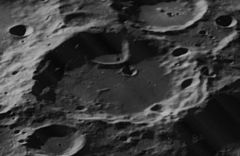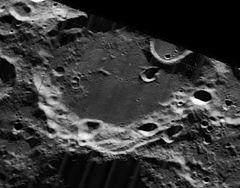 LRO image | |
| Coordinates | 45°12′N 113°18′W / 45.2°N 113.3°W |
|---|---|
| Diameter | 88 km |
| Depth | Unknown |
| Colongitude | 115° at sunrise |
| Eponym | Alfred L. Wegener |

Wegener is a lunar impact crater that is located in the Moon's northern hemisphere, about midway between the equator and the north pole. It lies on the far side from the Earth, behind the northwestern limb. The southwestern rim of Wegener intrudes slightly into the much larger walled plain Landau. Attached to the eastern rim is the crater Stefan.
This crater is in an intermediate stage of impact erosion, with a worn rim and some craters overlapping the edge and inner wall. The rim is generally more eroded in the northern half. A small crater lies across the western inner wall and part of the interior floor. There is a small, cup-shaped craterlet just to the east of this feature. The inner wall is wider in the southern half, leaving some irregularities on the southern half of the floor. The remainder of the interior is a nearly level and featureless plain.
Wegener lies at the approximate margin of the Coulomb-Sarton Basin, a 530 km wide impact crater of Pre-Nectarian age.
The crater was named after the German geophysicist, polar researcher and meteorologist Alfred Wegener, originator of the theory of Plate tectonics.
Satellite craters
By convention these features are identified on lunar maps by placing the letter on the side of the crater midpoint that is closest to Wegener.
| Wegener | Latitude | Longitude | Diameter |
|---|---|---|---|
| K | 43.3° N | 111.9° W | 32 km |
| W | 47.5° N | 116.1° W | 54 km |
References
- Andersson, L. E.; Whitaker, E. A. (1982). NASA Catalogue of Lunar Nomenclature. NASA RP-1097.
- Blue, Jennifer (July 25, 2007). "Gazetteer of Planetary Nomenclature". USGS. Retrieved 2007-08-05.
- Bussey, B.; Spudis, P. (2004). The Clementine Atlas of the Moon. New York: Cambridge University Press. ISBN 978-0-521-81528-4.
- Cocks, Elijah E.; Cocks, Josiah C. (1995). Who's Who on the Moon: A Biographical Dictionary of Lunar Nomenclature. Tudor Publishers. ISBN 978-0-936389-27-1.
- McDowell, Jonathan (July 15, 2007). "Lunar Nomenclature". Jonathan's Space Report. Retrieved 2007-10-24.
- Menzel, D. H.; Minnaert, M.; Levin, B.; Dollfus, A.; Bell, B. (1971). "Report on Lunar Nomenclature by the Working Group of Commission 17 of the IAU". Space Science Reviews. 12 (2): 136–186. Bibcode:1971SSRv...12..136M. doi:10.1007/BF00171763.
- Moore, Patrick (2001). On the Moon. Sterling Publishing Co. ISBN 978-0-304-35469-6.
- Price, Fred W. (1988). The Moon Observer's Handbook. Cambridge University Press. ISBN 978-0-521-33500-3.
- Rükl, Antonín (1990). Atlas of the Moon. Kalmbach Books. ISBN 978-0-913135-17-4.
- Webb, Rev. T. W. (1962). Celestial Objects for Common Telescopes (6th revised ed.). Dover. ISBN 978-0-486-20917-3.
- Whitaker, Ewen A. (1999). Mapping and Naming the Moon. Cambridge University Press. ISBN 978-0-521-62248-6.
- Wlasuk, Peter T. (2000). Observing the Moon. Springer. ISBN 978-1-85233-193-1.
